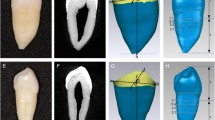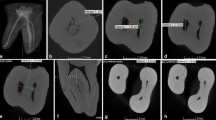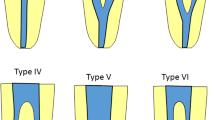Abstract
This study analyzed the root trunk (RT) and the pre-furcation area (PFA) of mandibular first molars. Thirty lower first mandibular molars extracted due to advanced periodontal disease were evaluated in a high-energy spiral computerized micro-tomography. Two gutta-percha markings on the cementoenamel junction (CEJ) and at the furcation entrance (FE) at buccal and lingual surfaces served as reference points for measurements of RT length, and PFA width and depth, at the levels of CEJ, 1 mm apical to CEJ, 2 mm apical to CEJ, and at the FE. The mean RT length was 2.49 mm at buccal and 3.18 mm at lingual sides. The mean widths of the PFA at CEJ, at 1 and 2 mm apical to CEJ, and at FE were 2.9, 3.4, 3.9 and 4.3 mm, respectively, while the mean depths were 0.19, 0.32, 0.57 and 1.1 mm, respectively. The PFA coincided with CEJ in 10 buccal and 10 lingual surfaces, representing 33.33% of the sample. There was a negative correlation between RT length and PFA dimensions. This study concludes that the RT length was smaller than previous studies. From the CEJ up to the furcation entrance, the PFA showed a progressive increase in width and depth. The coincidence of the PFA area beginning at the CEJ in 1/3, and the negative correlation between RT length and PFA dimensions may represent greater risk factor for the early development of furcation lesions.



Similar content being viewed by others
References
Silva N, Abusleme L, Bravo D, Dutzan N, Garcia-Sesnich J, Vernal R, et al. Host response mechanisms in periodontal diseases. J Appl Oral Sci. 2015;23:329–55. https://doi.org/10.1590/1678-775720140259.
Graziani F, Gennai S, Karapetsa D, Rosini S, Filice N, Gabriel H, et al. Clinical performance of access flap in the treatment of class II furcation defects. A systematic review and meta-analysis of randomized clinical trials. J Clin Periodontol. 2015;42:169–81. https://doi.org/10.1111/jcpe.12327.
Kinaia B, Steiger J, Neely A, Shah H, Bhola M. Treatment of class II molar furcation involvement: meta-analyses of reentry results. J Periodontol. 2011;82:413–28. https://doi.org/10.1902/jop.2010.100306.
Pruthi VK, Gelskey SC, Mirbod SM. Furcation therapy with bioabsorbable collagen membrane: a clinical trial. J Can Dent Assoc. 2002;68:610–5 (PMID: 12410941).
Casarin RC, Ribeiro EP, Nociti FH, Sallum AW, Ambrosano GM, Sallum EA, et al. Enamel matrix derivative proteins for the treatment of proximal class II furcation involvements: a prospective 24-month randomized clinical trial. J Clin Periodontol. 2010;37:1100–9. https://doi.org/10.1111/j.1600-051X.2010.01614.x.
Matthews D. Evidence is weak that use of tissue regenerative membranes may improve class II molar furcation defects over open-flap debridement alone. Evid Based Dent Pract. 2012;12:10–1. https://doi.org/10.1016/j.jebdp.2011.12.005.
Nibali L, Zavattini A, Nagata K, Di Iorio A, Lin GH, Agulha I, et al. Tooth loss in molars with and without furcation involvement—a systematic review and meta-analysis. J Clin Periodontol. 2016;43:156–66. https://doi.org/10.1111/jcpe.12497.
Peeran SW, Thiruneervannan M. Anatomy of mandibular molar furcation and its clinical implications. Sebha Med J. 2007;6:66–9.
Barboza C Jr, Tristão GC, Petersen R, Rodrigues DM, Barboza ESP. Biometric study of the prefurcation area of human mandibular first molar. Int J Periodontics Restorative Dent. 2014;34:857–61. https://doi.org/10.11607/prd.1971.
Gher ME, Vernino AR. Root morphology—clinical significance in pathogenesis and treatment of periodontal disease. J Am Den Ass. 1980;101:627–33.
de los Rios CM, Pustiglioni FE, Romito GA. Biometric study of the width, length and depth of the root trunk groove of human lower second molars. Pesqui Odontol Bras. 2002;16:26–30 (PMID: 11938714).
Roussa E. Anatomic characteristics of the furcation and root surfaces of molar teeth and their significance in the clinical management of marginal periodontitis. Clin Anat. 1998;11:177–86. https://doi.org/10.1002/(SICI)1098-2353(1998)11:3%3c177.
Kato A, Inagaki K, Utsumi M, Kato K, Honda M. Micro-computed tomography analysis of the relationship between root canal number and root concavity in maxillary first and second molars in a Japanese population. Odontology. 2021;109(1):193–200. https://doi.org/10.1007/s10266-020-00512-0.
Liu X, Gao M, Bai Q, Ruan J, Lu Q. Evaluation of palatal furcation groove and root canal anatomy of maxillary first premolar: a CBCT and Micro-CT study. Biomed Res Int. 2021;8(2021):8862956. https://doi.org/10.1155/2021/8862956.
Li J, Li L, Pan Y. Anatomic study of the buccal root with furcation groove and associated root canal shape in maxillary first premolars by using micro-computed tomography. J Endod. 2013;39(2):265–8. https://doi.org/10.1016/j.joen.2012.10.003.
Keleş A, Keskin C, Alqawasmi R, Versiani MA. Micro-computed tomographic analysis of the mesial root of mandibular first molars with bifid apex. Arch Oral Biol. 2020;117: 104792. https://doi.org/10.1016/j.archoralbio.2020.104792.
Barsness SA, Bowles WR, Fok A, McClanahan SB, Harris SP. An anatomical investigation of the mandibular second molar using micro-computed tomography. Surg Radiol Anat. 2015;37(3):267–72. https://doi.org/10.1007/s00276-014-1364-9.
Bertl K, Domic D, Hirtler L, Heimel P, Esfandeyari A, Stavropoulos A, Ulm C. Micro-CT evaluation of the cortical bone micro-architecture in the anterior and posterior maxilla and the maxillary sinus floor. Clin Oral Investig. 2019;23(3):1453–9. https://doi.org/10.1007/s00784-018-2573-0 (Epub 2018 Aug 15 PMID: 30112634).
Irie MS, Rabelo GD, Spin-Neto R, Dechichi P, Borges JS, Soares PBF. Use of micro-computed tomography for bone evaluation in dentistry. Braz Dent J. 2018;29(3):227–38. https://doi.org/10.1590/0103-6440201801979 (PMID: 29972447).
De-Deus G, Belladonna FG, Zuolo AS, Cavalcante DM, Simões Carvalho M, Marinho A, Souza EM, Lopes RT, Silva EJNL. 3-dimensional ability assessment in removing root filling material from pair-matched oval-shaped canals using thermal-treated instruments. J Endod. 2019;45(9):1135–41. https://doi.org/10.1016/j.joen.2019.06.003 (Epub 2019 Jul 23 PMID: 31350048).
Volponi A, Pelegrine RA, Kato AS, Stringheta CP, Lopes RT, Silva ASS, Bueno CEDS. Micro-computed tomographic assessment of supplementary cleaning techniques for removing bioceramic sealer and gutta-percha in oval canals. J Endod. 2020;46(12):1901–6. https://doi.org/10.1016/j.joen.2020.09.010 (Epub 2020 Sep 19 PMID: 32961214).
De-Deus G, Belladonna FG, de Siqueira ZA, Perez R, Carvalho MS, Souza EM, Lopes RT, Silva EJNL. Micro-CT comparison of XP-endo Finisher and passive ultrasonic irrigation as final irrigation protocols on the removal of accumulated hard-tissue debris from oval shaped-canals. Clin Oral Investig. 2019;23(7):3087–93. https://doi.org/10.1007/s00784-018-2729-y (Epub 2018 Nov 12 PMID: 30417226).
Silva EJNL, Carvalho CR, Belladonna FG, Prado MC, Lopes RT, De-Deus G, Moreira EJL. Micro-CT evaluation of different final irrigation protocols on the removal of hard-tissue debris from isthmus-containing mesial root of mandibular molars. Clin Oral Investig. 2019;23(2):681–7. https://doi.org/10.1007/s00784-018-2483-1 (Epub 2018 May 10 PMID: 29744723).
Von Elm E, Altman DG, Egger M, Pocock SJ, Gotzsche PC, Vandenbroucke JP. The strengthening the reporting of observational studies in epidemiology (STROBE) statement: guidelines for reporting observational studies. Int J Surg. 2014;12:1495–9. https://doi.org/10.1016/j.ijsu.2014.07.013.
Feldkamp LA, Davis LC, Kress JW. Pratical cone-beam algorithm. J Opt Soc Am. 1984;1:612–9.
Papapanou PN, Susin C. Periodontitis epidemiology: is periodontitis under-recognized, over-diagnosed, or both? Periodontol. 2000;2017(75):45–51. https://doi.org/10.1111/prd.12200.
Caton JG, Armitage G, Berglundh T, Chappl ILC, Jepsen S, Kornman KS, et al. A new classification scheme for periodontal and peri-implant diseases and conditions—Introduction and key changes from the 1999 classification. J Clin Periodontol. 2018;45:1–8. https://doi.org/10.1111/jcpe.12935.
Novaes AB, Tarnani JP, Oliveira PT, Palioto DB, Almeida ALG. Root trunk concavities as a risk factor for regenerative procedures of class II furcation lesions in dogs. J Periodontol. 2001;72:612–9 (PMID:11394396).
Dunlap RM, Gher ME. Root surface measurements of the mandibular first molar. J Periodontol. 1985;56:234–8. https://doi.org/10.1902/jop.1985.56.4.234.
Chiu BM, Zee KY, Corbet E, Holmgren CJ. Periodontal implications of furcation entrance dimensions in Chinese first permanent molars. J Periodontol. 1991;62:308–11. https://doi.org/10.1902/jop.1991.62.5.308.
Author information
Authors and Affiliations
Corresponding author
Ethics declarations
Conflict of interest
The authors declare that they have no conflict of interest.
Ethical approval
All the procedures performed in this study were conducted in accordance with the ethical standards of the Institutional Research Ethics Committee of the Universidade Federal Fluminense Medical School, and with the 1964 Helsinki Declaration and its later amendments or comparable ethical standards.
Additional information
Publisher's Note
Springer Nature remains neutral with regard to jurisdictional claims in published maps and institutional affiliations.
Rights and permissions
About this article
Cite this article
Perminio, D.J., Rodrigues, D.M., Vianna, K.C. et al. Micro-tomographic analysis of the root trunk and pre-furcation area of the first mandibular molars. Odontology 110, 120–126 (2022). https://doi.org/10.1007/s10266-021-00645-w
Received:
Accepted:
Published:
Issue Date:
DOI: https://doi.org/10.1007/s10266-021-00645-w




